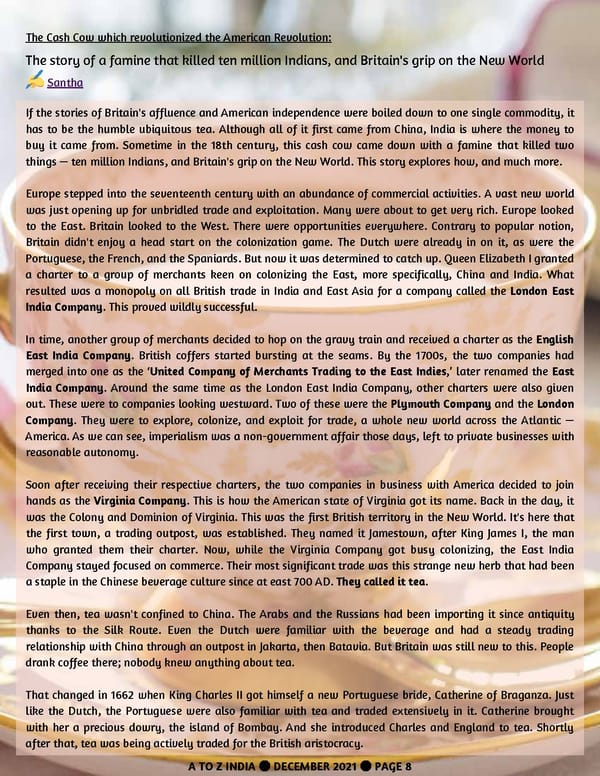If the stories of Britain's affluence and American independence were boiled down to one single commodity, it has to be the humble ubiquitous tea. Although all of it first came from China, India is where the money to buy it came from. Sometime in the 18th century, this cash cow came down with a famine that killed two things — ten million Indians, and Britain's grip on the New World. This story explores how, and much more. Europe stepped into the seventeenth century with an abundance of commercial activities. A vast new world was just opening up for unbridled trade and exploitation. Many were about to get very rich. Europe looked to the East. Britain looked to the West. There were opportunities everywhere. Contrary to popular notion, Britain didn't enjoy a head start on the colonization game. The Du tch were already in on it, as were the Portuguese, the French, and the Spaniards. But now it was determined to catch up. Queen Elizabeth I granted a charter to a group of merchants keen on colonizing the East, more specifically, China and India. What resulted was a monopoly on all British trade in India and East Asia for a company called the London East India Company . This proved wildly successful. In time, another group of merchants decided to hop on the gravy train and received a charter as the English East India Company . British coffers started bursting at the seams. By the 1700s, the two companies had merged into one as the ‘ United Company of Merchants Trading to the East Indies ,’ later renamed the East India Company . Around the same time as the London East India Company, other charters were a lso given out. These were to companies looking westward. Two of these were the Plymouth Company and the London Company . They were to explore, colonize, and exploit for trade, a whole new world across the Atlantic — America. As we can see, imperialism was a non-government affair those days, left to private businesses with reasonable autonomy. Soon after receiving their respective charters, the two compa nies in business with America decided to join hands as the Virginia Company . This is how the American state of Virginia got its name. Back in the day, it was the Colony and Dominion of Virginia. This was the first British territory in the New World. It's here that the first town, a trading outpost, was established. They named it Jamestown, after King James I, the man who granted them their charter. No w, while the Virginia Company got busy colonizing, the East India Company stayed focused on commerce. Their most significant trade was this strange new herb that had been a staple in the Chinese beverage culture since at east 700 AD. They called it tea. Even then, tea wasn't confined to China. The Arabs and the Russians had been importing it since antiquity thanks to the Silk Route. Even the Dutch wer e familiar with the beverage and had a steady trading relationship with China through an outpost in Jakarta, then Batavia. But Britain was still new to this. People drank coffee there; nobody knew anything about tea. That changed in 1662 when King Charles II got himself a new Portuguese bride, Catherine of Braganza. Just like the Dutch, the Portuguese were also familiar with tea and traded extensively in it. Catherine brought with her a precious dowry, the island of Bombay. And she introduced Charles and England to tea. Shortly after that, tea was being actively traded for the British aristocracy. Santha A TO Z INDIA ● DECEMBER 2021 ● PAGE 8 The story of a famine that killed ten million Indians, and Britain's grip on the New World The Cash Cow which revolutionized the American Revolution:
 A TO Z INDIA - DECEMBER 2021 Page 7 Page 9
A TO Z INDIA - DECEMBER 2021 Page 7 Page 9